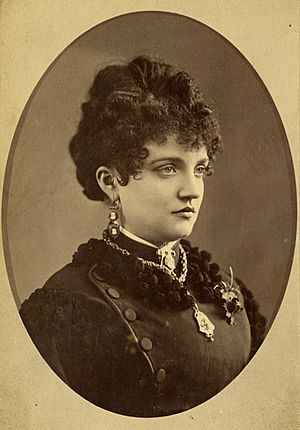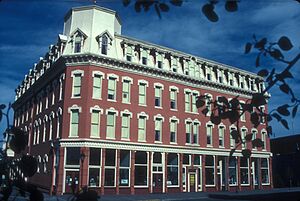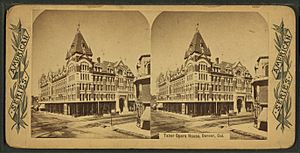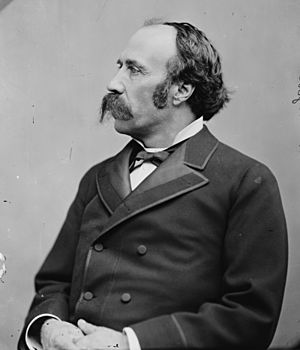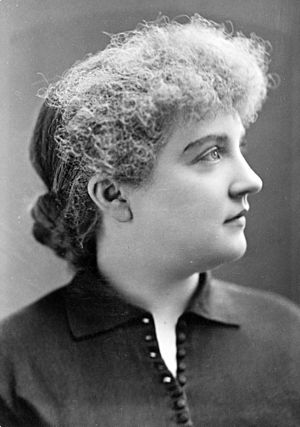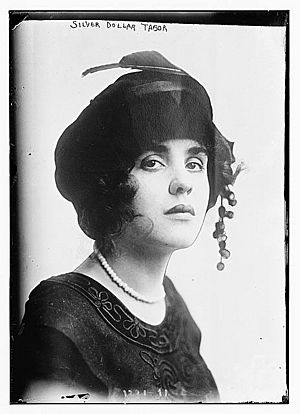Baby Doe Tabor facts for kids
Elizabeth McCourt Tabor (born September 1854 – died March 7, 1935), known to many as Baby Doe, was a famous woman from Colorado's history. She was the second wife of a wealthy businessman named Horace Tabor. Her life story was quite dramatic, going from being very poor, then incredibly rich, and then poor again. This amazing journey even inspired an opera and a Hollywood movie!
Baby Doe was born in Oshkosh, Wisconsin. In the mid-1870s, she moved to Colorado with her first husband, Harvey Doe. Later, they divorced.
She then moved to Leadville, Colorado, a busy mining town, where she met Horace Tabor. Horace was a very rich "silver king," meaning he made his money from silver mines. He was almost twice her age. In 1883, Horace divorced his first wife, Augusta Tabor, and married Baby Doe in Washington, D.C.. This happened while he was briefly serving as a US senator. After their wedding, they lived in Denver.
Horace Tabor was one of the richest men in Colorado and gave Baby Doe a very fancy lifestyle. However, he lost all his money when a law called the Sherman Silver Purchase Act was cancelled. This caused a big financial crisis in 1893, especially in places like Colorado that relied on silver. Many people went bankrupt. Horace died without any money. Baby Doe then returned to Leadville with her two daughters and lived there for the rest of her life.
Once known as the "best dressed woman in the West," Baby Doe spent her last 30 years living in a small cabin at the Matchless Mine. She lived in great poverty and mostly alone. In March 1935, after a big snowstorm, she was found frozen in her cabin. She was about 81 years old. Her life story is remembered in the opera The Ballad of Baby Doe.
Contents
Early Life and First Marriage
Elizabeth Bonduel McCourt was born in September 1854 in Oshkosh, Wisconsin. Her parents were Irish-Catholic immigrants. As a child, she was called Lizzie. She was the fourth of eleven children and grew up in a middle-class family. Her father owned a clothing store and the first theater in Oshkosh, called McCourt Hall. Her mother believed Lizzie's good looks would help her become an actress. Her father, however, thought it was better for her to work in the clothing store.
Oshkosh was a town known for its lumber mills. In 1874 and 1875, big fires swept through Oshkosh. The McCourt family lost their home, store, and theater. They borrowed money to rebuild, which put her father deeply in debt. The family then had to live on very little money.
In 1876, Lizzie McCourt met Harvey Doe. She impressed him by winning a skating competition as the only woman contestant. Lizzie and Harvey married in 1877. They then traveled to Colorado with Harvey's father to check on his mining investments. Their most important investment was half-ownership of the Fourth of July Mine in Central City. After a short honeymoon in Denver, the newlyweds joined Harvey's father in the mining town. Lizzie loved Colorado. It was here that she might have gotten her nickname, "Baby Doe."
Moving to Colorado
In Central City, Baby Doe quickly realized her husband, Harvey, was not suited for the rough mining town. He struggled to manage the mine on his own. Wanting to help and excited about the idea of finding gold, she worked alongside him. She often dressed in mining clothes and worked directly in the mine. While the mining town had a relaxed culture, some people in high society thought her behavior and clothing were shocking. Despite their efforts, the Does found only a small amount of gold. When the mine shaft collapsed, Harvey gave up and took a job as a regular worker at another mine. He told Baby Doe to stop wearing men's clothes and stay home.
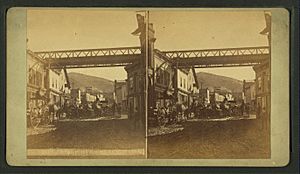
They then moved from Central City to Black Hawk to live in a cheaper room. Baby Doe was very disappointed by the noise and dirt in Black Hawk. She often took walks around the city. She didn't have skills for domestic work and had little in common with the other women. She often visited the local clothing store, drawn by the expensive fabrics. She became friends with the store owner, Jake Sandelowsky. Around this time, Harvey lost his job, and their marriage began to fall apart.
Baby Doe followed Harvey to Denver, where she filed for divorce. She then moved to Leadville, Colorado, likely invited by Jake Sandelowsky, who had changed his name to Sands. Alone and without a husband, Baby Doe needed money quickly. Jake Sandelowsky, who opened a store in Leadville, offered her a job. He also seemed to want to marry her. However, Baby Doe found the idea of working in a clothing store boring, like the life she had left behind in Oshkosh.
Life in Leadville
In Leadville, Baby Doe caught the eye of Horace Tabor. He was a millionaire from mining and owned Leadville's famous Matchless Mine. Horace was married, but in 1880, he left his wife Augusta Tabor to be with Baby Doe.
Baby Doe met Horace Tabor in a Leadville restaurant in 1880. She shared her story with him. Tabor immediately gave her $5,000. Baby Doe then sent a message, and $1,000, to Jake Sandelowsky, saying she would not marry him. Sandelowsky later moved to Aspen, where he opened another store, got married, and built a house.
Baby Doe and Horace Tabor fell in love. He moved out of his Denver home and asked his wife Augusta for a divorce, but she refused. Despite still being married to Augusta, Horace Tabor and Elizabeth McCourt Doe secretly married in St. Louis, Missouri, in September 1882.
Marriage to Horace Tabor
In January 1883, Horace Tabor finally got a legal divorce from Augusta. He gave her real estate in Denver and shares in his mines. That same month, Horace was appointed to be a United States Senator for a short time. Baby Doe and Horace publicly married on March 1, 1883, just two months after his divorce. The wedding took place at the Willard Hotel in Washington, DC, during Horace's time as a senator. Baby Doe invited important people like President Chester A. Arthur, and many attended.
She planned a very fancy wedding. She went to Oshkosh to arrange for her family to attend and bought them clothes and jewelry. Her mother was proud that her daughter was marrying a rich man. Two days after the wedding, the priest who performed the ceremony refused to sign the marriage license. He learned that both Horace and Baby Doe had been divorced before and that Baby Doe was Catholic. While many people had ignored Horace's relationship with Baby Doe before, his divorce and quick remarriage caused a big scandal. This made it hard for the couple to be accepted by polite society. A few months later, Horace tried to become governor of Colorado but failed. Baby Doe's father also died around this time.
The couple returned to Colorado and lived in a large mansion in Denver. Other wealthy women in Denver did not welcome Baby Doe. She didn't join charities or clubs, which was common for rich women then. However, she was very generous with her money, donating to various charities and providing free offices for the Colorado suffragette movement (which worked for women's right to vote). To keep busy, she shopped, bought jewelry and clothes, and continued her hobby of scrapbooking.
On July 13, 1884, she gave birth to their first daughter, Elizabeth Bonduel Lily Tabor. The baby was christened in a very expensive outfit. Baby Doe was a good mother, staying home with her daughter instead of traveling with Horace on his many business trips. Their second daughter, Rose Mary Echo Silver Dollar Tabor, was born on December 17, 1889. Both girls were pretty and well cared for, and their mother adored them. The second child was lovingly called Silver or Silver Dollar.
In 1890, a year after their second child was born, the Sherman Silver Purchase Act was passed. This gave hope to Colorado and its mine owners that silver prices would become stable. Profits from silver mining had been dropping as the supply decreased and costs increased. When some of Horace's investments started to fail, he had to mortgage his Denver theater and other properties he had bought.
Horace Tabor lost his fortune in 1893 when the Silver Act was cancelled. This caused the Panic of 1893. Silver prices crashed, and many fortunes in Colorado disappeared instantly. Just like with her first husband, Baby Doe stepped in to help. Horace gave her the legal power to manage his businesses in Denver, and she made decisions for him when he was away. To raise money, she sold most of her jewelry. When the power was turned off in their mansion, she made it a game for the children. Eventually, the mansion and everything inside it were sold. At age 65, Horace took a job as a regular mine worker to earn money, and the family lived in a boarding house. From 1893 to 1898, the Tabors lived in great poverty, though some friends lent them money. To help him, some political friends arranged for him to become the postmaster of Denver in 1898. The family lived on his salary of $3,700 per year and stayed in a simple room at the Windsor Hotel. Horace's health soon failed, and he died 15 months after becoming postmaster.
His funeral was very well attended, with perhaps as many as 10,000 people there. On his deathbed, he is said to have told Baby Doe to "hold on to the Matchless mine… it will make millions again when silver comes back." However, this story might not be true, as it seems they had already lost or mortgaged the Matchless mine by then.
Later Years
The Matchless Mine
After her husband's death, Baby Doe stayed in Denver for a while. It's not clear why she decided to leave Denver and return to Leadville, high in the cold mountains. However, it was almost certainly because of the Matchless mine. For two years, she tried to find people to invest money to get the Matchless mine working again, but she was not successful. The family may have tried to get the Matchless mine back, but the records are unclear about who owned it then. In 1901, one of her sisters may have tried to buy the mine, but again, the records are confusing. When Baby Doe moved back to Leadville with her daughters, she said she would work the mine herself, even though it was in bad shape. The mine's shafts were flooded and had not been working for many years. To earn money, she took on simple household jobs. Unknown to her, her brother secretly paid the grocer so the three women would have food. Eventually, to try and keep the mine going and raise money, she sadly sold the "Isabella necklace" that Horace had given her. But she refused to sell his gold watch fob during her lifetime.
Her older daughter, Lily, left her mother to live with Baby Doe's family in Wisconsin. Later, after her mother died, Lily denied being Baby Doe's daughter. Lily, who was born into wealth, seemed more affected by their fall into poverty. In 1902, when Baby Doe and her daughters visited relatives in Oshkosh, Lily decided to stay and care for her elderly grandmother. Later, Lily moved to Chicago, where she married her first cousin in 1908 and soon had Baby Doe's grandchild. In 1911, Baby Doe and Silver visited relatives in Wisconsin again, then went to see Lily in Chicago. After such a long time apart, Lily claimed she barely knew Silver Dollar.
After Lily left, Baby Doe and Silver Dollar moved into a small cabin at the Matchless mine site. The cabin was very basic and not suitable for Colorado winters. It was no bigger than a medium-sized room, with two windows that had been nailed shut. The cabin was a former tool shed next to the hoist house. A visitor in 1927 described it as "crowded with very primitive furniture, decorated with religious pictures, and stacked high in newspapers." The cabin was isolated, located above Leadville, and had a clear view of Mount Elbert and Mount Massive.
Baby Doe soon sent Silver Dollar away to Denver. There, Silver Dollar wrote for the Denver Times newspaper, sending some of her earnings to her mother each week. She then tried to become a novelist. Perhaps to escape Colorado, she moved to Chicago, where she again tried writing. Eventually, after working as a dancer under different names, she met a Chicago gangster. In 1925, Silver Dollar was found dead under suspicious circumstances in her Chicago boarding house.
Alone in the cabin outside Leadville, Baby Doe turned to religion. She saw her time of great wealth as a period of being too proud and created ways to punish herself. During the very cold Colorado winters, she wrapped burlap sacks around her legs. With no money, she ate very little, living on old bread and animal fat, and refused to accept help. Baby Doe lived like this for 35 years. During these years, she wrote constantly. In her diaries, letters, and scraps she called "Dreams and Visions," about 2,000 pieces of writing were later found bundled in piles of paper in her cabin.
She walked the streets of Leadville, with rags on her feet and wearing a cross. People began to think of her as a madwoman. Some who had known her earlier thought she deserved to suffer for breaking up Horace and Augusta's marriage and believed she had caused his ruin. By this time, Leadville had lost many of its people and was becoming a ghost town. She often walked the empty streets at night, dressed in a mix of women's and men's clothing, wearing trousers and mining boots. She protected the mine from strangers with a shotgun. She became a sad reminder of her past self to older residents and a strange sight to the young.
Death
In the winter of 1935, after a very bad snowstorm, some neighbors noticed that no smoke was coming from the chimney at the Matchless mine cabin. When they investigated, they found Baby Doe dead, her body frozen on the floor. For one last time, Baby Doe made the front pages of the newspapers. A funeral service was held in Leadville, then her coffin was sent by train to Denver. She was apparently 81 years old when she died.
Her remaining belongings were sold at auction to collectors for $700. Baby Doe Tabor is buried with her husband in Mount Olivet Cemetery in Wheat Ridge, Colorado.
Legacy
Baby Doe Tabor is a famous figure among the women of the American West. She is remembered as a great beauty. In her later years, some saw her as a lonely, troubled woman. Her story, and the ideas about her, grew quickly over time. People sometimes rumored she was only interested in money or was a bad mother. After her death, people searched for treasure that didn't exist. However, the real treasure was found in Baby Doe's writings, which have taken many years to organize and study. These writings are now starting to show us more about her inner life.
Baby Doe was shown in the Warner Brothers film Silver Dollar, which first showed in Denver in 1932. The character based on Baby Doe was played by actress Bebe Daniels. Douglas Moore's opera The Ballad of Baby Doe first played in Central City, Colorado, in 1956. In the New York premiere in 1958, Baby Doe's part was sung by Beverly Sills. In the 1970s, several restaurants called "Baby Doe's Matchless Mine" opened in different US cities, but most are now closed.
In 1985, Baby Doe Tabor was honored by being added to the Colorado Women's Hall of Fame.
See also
- Silver Dollar (film)


